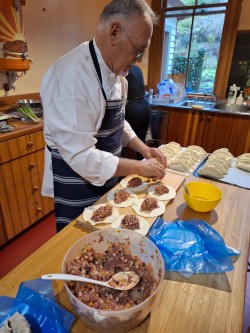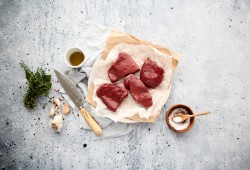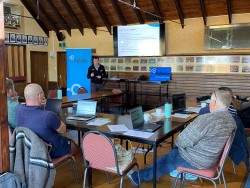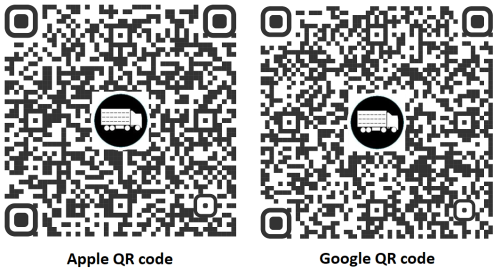Jul 19, 2024
Click a heading below or scroll down to read
Main
- Changes at the top for DINZ
- Unworkable freshwater targets push ahead in the regions
- Health, food safety returns to front of mind in China
In Brief
- Positive news for frozen velvet China market access
- NZ venison proves popular at Paris Olympics
- Next generation of NZ deer farmers gather in Central Region
- DINZ, DFA join forces, meet with Nelson farmers
- Venison companies starting to confirm 2024 chilled contracts
- NVSB annual fee to increase, VelTrak price increase signaled for future
- Pilot IFP workshop kicks off farm planning push
- MPI Fit for Technology
Positive news for frozen velvet China market access
Good progress has been made toward restoring market access for New Zealand’s frozen deer velvet exports to China.
Agreement has been reached between the respective government agencies on the new formal arrangement’s content. There is good-faith intention amongst the regulators for trade to resume for the upcoming 24/25 season.
MPI is drafting separate lists of premises and developing Health Certificates for frozen and dried velvet for China’s approval and implementation. Once finalised, the Overseas Market Access Requirements (OMARs) for China will then be updated to enable the new certificates to be used.
DINZ CEO Rhys Griffiths noted, “This progress is a testament to MPI’s dedication throughout the process, reflecting a shared commitment to maintaining robust safety systems and advancing the economic prosperity of New Zealand.
“We extend our gratitude to MPI officials in Wellington and Beijing for getting us to this point and acknowledge the efforts of all parties involved from both New Zealand and China.”
This marks good progress towards the long-term sustainability of our trade with China and opening doors to new opportunities for value-added deer velvet products, a wider range of sales channels, and an expanded customer base.
NZ venison proves popular at Paris Olympics
Venison was a popular menu item at New Zealand House – the venue for Kiwi athletes, their families, VIPs and dignitaries, and Kiwi fans visiting the Olympics – and was featured at the celebratory BBQ after the Games’ closing ceremony.

DINZ chef Shannon Campbell (kneeling) with Gemma Baldwin and Matt Owens from Alliance UK and the Kiwi mascot.
Europe-based DINZ chef Shannon Campbell helped design the menu at New Zealand House and was there to cook for the closing ceremony BBQ.
“The whole Olympics was just awesome,” says Campbell. “I’m still buzzing, to be honest.”
“After the closing ceremony BBQ at New Zealand House, where I had a chance to cook for all the hotel chefs, the Marriott team is placing an order for their autumn/winter menu. Pretty awesome, I’d say.”
New Zealand House was located inside the Marriott Hotel on the Champs Élysée, just down from the Arc de Triomphe. The venue had a two-storey outdoor dining area, with a big screen for viewing the events, and hospitality. A popular menu item on the daily lunch menu was the Olympian sandwich, featuring New Zealand venison loin with stewed kiwifruit and onion compote and cheese.
New Zealand House saw 15,000 visitors over the course of the Games, though not all ordered food.
Campbell himself cooked at the closing ceremony BBQ, where New Zealand venison was again featured – this time with a black BBQ rub and maple syrup glaze. The closing ceremony event was attended by Minister of Sport Chris Bishop, New Zealand ambassador to France Caroline Bilkey, and other assorted guests.
Was it New Zealand venison that led to the country’s largest ever medal haul? DINZ holds no official position on this, of course, but it does seem a mighty coincidence.
Next generation of NZ deer farmers gather in Central Region
The future of New Zealand deer farming came together 8-9 August at the New Zealand Deer Farmers’ Association (NZDFA) annual Next Generation conference in Palmerston North. The event, of which 2024 was the twelfth year, is aimed at bringing together young and aspiring deer farmers so that they might learn from those who have come before them, both on-farm and in the wider industry.
Next Generation attendees listen at the first of two farms on Day 1.
“Next Generation is a very important event on the annual NZDFA calendar,” says NZDFA executive committee chair Mark McCoard. “Each year we work to form a programme that exposes the attendees to a range of deer farming systems, processing, and marketing, as well as speakers that will support the opportunities available for those seeking a future in deer farming.
“As with other farming sectors, the average age of farmers is increasing. The more we continue to highlight the opportunities that deer farming and the wider industry present, the better placed we will be in the future. Succession planning and pathways into farming was a key focus at this year's event in the Central Regions.”
This year’s two-day event saw attendees visit two farms on the first day, followed by a tour of Venison Packers Feilding and classroom sessions on the benefits of a multi-species farm and pathways into deer farming on the second day.
For more in-depth coverage of this year’s Next Generation programme, check out the article from the NZDFA’s most recent Stagline newsletter online.
DINZ, DFA join forces, meet with Nelson farmers
On 17-18 July, the DINZ board and executive met in Nelson with another full agenda (see this issue’s lead story). On the evening of 17 July, the DINZ representatives met with the local DFA and farmers from the region for an informal Q&A session. Then-interim chair Gerard Hickey along with Rhys Griffiths (then in the interim CE position) led the discussion, while calling on respective members of the board, the DINZ team and DFA executive committee members to answer specific questions where needed.

DINZ executive chef Graham Brown prepares venison dumplings for the crowd in attendance. (Photo credit: Lynda Gray)
"It was great to get down to Nelson and meet with farmers, as it always is no matter where in the country we are,” says now permanent CEO Rhys Griffiths. “It’s so important for us to know what our producers are thinking, what is front and centre of their minds at any given moment.”
When asked if he had any inkling of the permanent role to come, Grifiths said, “Not at all, but I am honoured to have been given the opportunity.”
The main topics for conversation were as expected: venison prices, velvet access to China (see earlier article this issue for an update), and around the search for a permanent CEO (see this issue’s lead article). NZDFA executive committee chair Mark McCoard spoke of the need to get more hinds behind fences and build up the national herd.
The event format was well-received by attendees, with its more informal setting and Q&A session allowing for better engagement and two-way communication.
“Allowing farmers the opportunity to directly raise any issues or questions from the floor ensured that what was discussed was relevant to those in attendance,” says McCoard.
“Having representation from the DINZ board and executive, combined with members of the NZDFA executive committee, ensured that topics raised could be responded to in a very balanced way. It certainly highlighted the differing strengths that both DINZ and the NZDFA provide in support of deer farmers and the wider deer industry.”
Venison companies starting to confirm 2024 chilled contracts
Venison companies are actively negotiating with their European customers for the 2024 new season chilled contracts and are starting to secure contracts at slightly higher prices than last year.
 Silver Fern Farms (SFF) and First Light Venison are now offering suppliers contracts with prices around $10.50 per kg, depending on timing and conditions. Other marketers are also anticipating similar prices, though they are still in negotiations, with Alliance Group hoping to have theirs completed soon.
Silver Fern Farms (SFF) and First Light Venison are now offering suppliers contracts with prices around $10.50 per kg, depending on timing and conditions. Other marketers are also anticipating similar prices, though they are still in negotiations, with Alliance Group hoping to have theirs completed soon.
European buyers are showing reasonable interest, but they remain cautious, the companies report. Premium middle cuts are selling well with strong demand, while interest in leg and shoulder meat is weaker, due in part to competition from European domestic wild venison. There is also pressure on co-product prices.
Duncan NZ is focused on lifting market prices, “in line with the need to offset rising costs throughout the entire supply chain”. While its customers do understand price increases are necessary, there is concern that if prices rise too high, “restaurants may take venison off the menu in favour of cheaper protein options,” it says.
While chilled venison is a smaller part of Mountain River Venison’s portfolio, the company is also offering seasonal minimum price contracts slightly up on last year. Aiming to maintain the farmgate price over the season for its suppliers, the company anticipates more demand than supply this year and is emphasising its long-term business growth.
“There’s plenty of opportunity out there,” for this sector’s premium niche product, it believes.
Europe is one leg of the three-legged venison stool. Exporters will also be keeping a close eye on the US market, where sales are going well, due to its potential economic uncertainties and political developments. In addition, a recent market visit to China for Silver Fern Farms highlighted softer demand for venison in that region. Discussions showed the “desire to buy was there, but that pricing was an issue,” they report.
This all underscores the ongoing challenge of balancing pricing for venison in a dynamic global market.
NVSB annual fee to increase, VelTrak price increase signaled for future
The annual fee paid to the National Velvetting Standards Body (NVSB) is set to increase to $239.13 plus GST, up from $217.39 plus GST previously.
The fees collected are used to run the NVSB programme, including auditing work, VelTrak and administration. The NVSB annual fee was last increased in 2018. Over the past six years, auditing costs have increased, along with costs associated with delivering the programme.
“DINZ and NVSB acknowledge that costs have risen behind the farmgate,” says DINZ CEO Rhys Griffiths, “and this was carefully considered, but the costs of running the programme have risen also. Ultimately, the decision was made to increase the NVSB fee this year instead of holding off and then needing a larger increase later.”
NVSB also signaled in their most recent communications that there is an intention to move to a cost recovery model for VelTrak tags. When VelTrak was introduced in 2019, it was always the intention to move in time to a full cost recovery model for the tags to ensure transparency and for ease of management.
The cost of VelTrak tags were kept the same as at the time of decision, there was uncertainty around market access to China for frozen velvet. While there has been some positive news on market access since the NVSB announcement, the price of the tags will remain the same until further notice.
“New Zealand velvet is sought after precisely because of the assurances the systems the deer industry has in place,” says Griffiths. “It is so, so critical that we manage these reputational tools as cleanly and efficiently as possible.”
With velvet season now upon us, make sure you keep an eye out for the annual NVSB Bulletin, coming soon.
Pilot IFP workshop kicks off farm planning push
In partnership with Deer Industry NZ and Rabobank, the Ballance Farm Sustainability team in Southland has recently finished facilitating their pilot integrated farm planning (IFP) workshop cohort in the Upper Aparima catchment.

Attendees listen to a presentation as part of a pilot IFP workshop. (Photo: provided by Ballance)
The workshop was well received by farmers in the region, and it now puts them in a strong position to work towards industry-driven assurance programmes, such as NZFAP Plus, along with covering local and national farm planning requirements.
The farmers were provided support to develop an online integrated farm plan, with topics including land and water, greenhouse gas management, biodiversity, and biosecurity.
Farmers who attended the pilot workshop said it was great to have local knowledgeable support, particularly for a non-tech person, and that leaving the workshop they felt more confident. There was also strong sentiment about the importance of working towards industry-driven schemes such as NZFAP Plus.
The first workshop is being planned for October in the Waikaka Catchment, if you are interested, please contact the Ballance Farm Sustainability team. We are still to determine the locations of all future Southland workshops, so we are looking for expressions of interest from deer farmers who are interested in attending to help us determine future locations. This is open to all farmers in Southland.
Please contact farm.sustainability@ballance.co.nz if you’re interested in being involved.
MPI Fit for Technology
The Ministry for Primary Industries (MPI) has released its Fit for Transport app – a mobile app that ensures all famers and transporters know their animal welfare obligations when preparing animals for transport. The app also makes clear how to identify which animals should not be transported.
The Fit for Transport app is available for both iOS and Android (see QR codes below). More information about the app can be found on MPI’s Fit for Transport page.

SHORTS
- Read/listen: “Farmstrong: How Harry Gaddum started farming again after Cyclone Gabrielle,” The Country, 21 August 2024
- Read: “'It's a waste of resources if we don't use the carcasses ' - Wild deer used in butchery classes,” Radio New Zealand, 23 July 2024
- Read/listen: “$100 a deer: New book recalls the deer-hunting boom times”, Radio New Zealand, 14 August 2024
- Read: “New Zealand’s economy depends on the environment; and vice versa - Dr Jacqueline Rowarth,” New Zealand Herald, 14 August 2024
- Read: “‘More scope’ for deer farm,” Otago Daily Times, 21 August 2024

EVENTS
Click on the bold links below to get more information about any of the events.
- 2024 National Velvet Competition and Awards - 5.00-11.00pm Saturday 14 December 2024, Ascot Hotel, Invercargill. Cost: TBA. Contact: Jane Campbell, southlanddeerbranch@gmail.com
- SAVE THE DATE!!! 2025 50th Anniversary Deer Industry Conference - Tuesday 13 May 2025, Queenstown. Details to follow.


